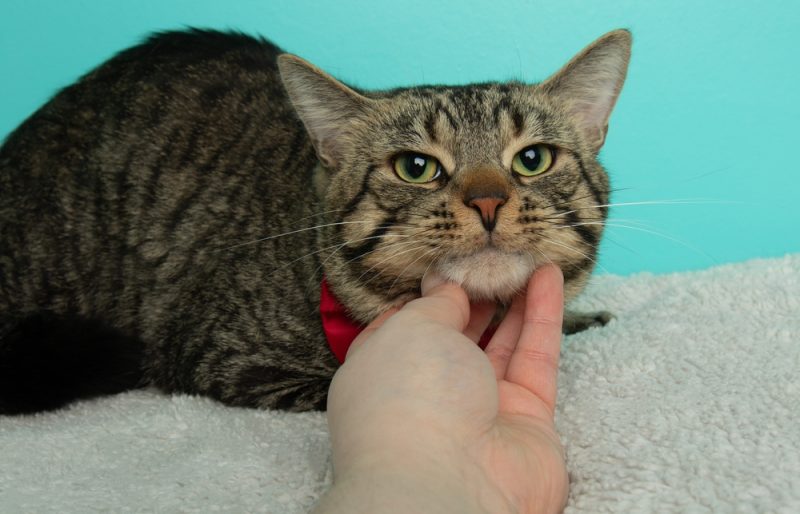The post Cat Eye Tumors & Cancer: Our Vet Explains the Causes, Signs & Care by Dr. Chyrle Bonk DVM (Veterinarian) appeared first on Catster. Copying over entire articles infringes on copyright laws. You may not be aware of it, but all of these articles were assigned, contracted and paid for, so they aren't considered public domain. However, we appreciate that you like the article and would love it if you continued sharing just the first paragraph of an article, then linking out to the rest of the piece on Catster.com.
Click to Skip Ahead
Cancer and tumors can affect any part of a cat’s body, even their eyes. Fortunately, eye tumors in cats are uncommon, if not rare. Unfortunately, they tend to be cancerous more often than benign and quite aggressive. Cancers can arise from any and all structures associated with the eye, including the tissues surrounding it, so there are different variations. Here, we examine the most common types of cat eye tumors so you know what they look like, what causes them, and what can be done about them.

What Are Cat Eye Tumors?
Eye tumors in cats are any abnormal growths in the eyeball itself, on the surface of the eye, or in the surrounding tissues, including the eyelids and conjunctiva. These tumors can have many different versions, depending on where they originate. Most are malignant or cancerous, though, and they tend to grow rapidly and spread to other parts of the body.
Primary eye tumors pop up directly from the structures in and around the eye. Secondary tumors that have spread from other areas of the body are possible but not as commonly seen. The most common eye tumors in cats are melanoma, squamous cell carcinoma, and post-traumatic ocular sarcoma.
Eye cancer tends to show up in one eye but can be seen in cases of secondary tumors that have traveled from other parts of the body. Since eye tumors in cats tend to be so aggressive, it’s important to be able to recognize them as early as possible in order to get treatment underway for the best outcome.

What Do Eye Tumors in Cats Look Like?
The first thing that you’ll likely see with a cat eye tumor is a kitty with sore eyes. They may rub or squint their eyes due to the discomfort. There may also be a large amount of tearing or discharge. The pain can either be due to irritation to the eyeball, conjunctiva from the tumor itself, or increases in pressure inside the eye brought on by the tumor disrupting the normal fluid cycle.
Any lumps or spots on the eyelid or conjunctiva tend to be pink or red, rough, and irregularly shaped. They often look like a sore that won’t heal and instead becomes worse. These types of tumors are often squamous cell carcinomas and are more common in white cats and those with a light color around their eyes.
Tumors within the eye will often show up as dark, irregularly shaped spots that creep across the surface of the eye. These are likely melanoma and will look similar to melanoma on the skin. Tumors within the eye can cause glaucoma, or an increase in pressure that may cause the eyeball to enlarge or even stick out a bit farther than normal.
Post-traumatic ocular sarcomas typically show up following an injury to the eye or chronic inflammation. In this case, you’ve likely been dealing with an eye issue in your cat already, followed by glaucoma or even a shrinking of the eyeball.
What Are the Causes of Eye Tumors in Cats?
Cat eye tumors are fairly uncommon, but when they do occur, it’s likely the result of a combination of factors, ranging from genetics to the environment. Sun exposure may be linked to squamous cell carcinomas in the eyelids and the surrounding tissues of light-colored cats. UV light may also be linked to melanomas within the eye.
Post-traumatic ocular sarcomas are tumors that can follow injuries or illnesses of the eye, such as chronic uveitis. These tumors often take several years to present, so you may not even associate the initial issue with the tumor when it finally shows up. There can also be a viral component to some cat eye cancers, with feline leukemia virus being the main culprit, increasing the risk for secondary lymphoma in a cat’s eye.
The exact cause of feline eye tumors may not be pinpointed in every case, but your vet should be able to diagnose the specific type of tumor that your cat has.
How Are Cat Eye Tumors Diagnosed?
Take your kitty to the veterinarian when you start noticing signs of discomfort, such as redness, watering, or rubbing of the eye. Your vet will take it from there, doing a thorough exam of the eye, testing the internal pressures, running bloodwork, and potentially, doing an ultrasound of the eye to determine the cause of the issue. X-rays of the chest may also be taken to see whether the cancer has spread to the lungs.
Your vet may refer you to a veterinary ophthalmologist for further diagnosis, or they may take a biopsy of the tumor to find out what it’s made of. The eye may need to be removed in order to biopsy tumors that are growing within.
How Do I Care for a Cat With an Eye Tumor?
Treating eye tumors will depend on the type that you’re dealing with. Squamous cell carcinomas or other types of tumors on the eyelids and conjunctiva may be removed surgically using a laser or cryotherapy. Large tumors may require removal of the eyeball, otherwise known as enucleation, along with the surrounding tissue and potentially, radiation or chemotherapy.
Tumors on the eye may be treated by a veterinary ophthalmologist or oncologist with laser removal +/- radiation and chemotherapy, depending on where the tumor is. However, the most common treatment for these tumors or those that are within the eyeball is the removal of the entire eyeball if the tumor hasn’t yet spread to the lungs or other parts of the body. Any underlying conditions should also be treated.
Removing an eye may seem like a scary prospect, but it’s important to know that not only can enucleation cure most ocular tumors that haven’t spread but also that cats often adjust quite well to life with one eye. They’ll need a bit of help from you initially but can live a fairly normal, healthy life afterward.
Following enucleation, you’ll need to monitor your cat’s incision for drainage, redness, and odor. They may be prescribed antibiotics and medications for the pain. Help them out by putting all their necessities, such as food and water bowls, litter box, and bed in easy-to-reach areas, preferably on the floor for the first couple of weeks while they get used to their new field of vision and depth perception. Over time, you can gradually move these things back to where you want them, while still offering your kitty plenty of praise and affirmation and helping them as needed.
Within a few weeks, most cats will feel fairly comfortable in their surroundings and can go back to their normal lives.


Frequently Asked Questions (FAQ)
Can Cat Eye Tumors Be Prevented?
While there is no significant way to prevent eye tumors in cats, you can help by decreasing the amount of sun exposure that your kitty gets, especially if they’re light colored. Also, make sure your cat is up to date on vaccinations and help avoid eye injuries by supervising all interactions with unfamiliar animals.
Is Cat Eye Cancer Painful?
Tumors in and around the eye are often quite painful for cats. They may cause redness and swelling of the tissues around the eye, or they may increase the internal pressures, causing the eye to enlarge and bulge out. Felines with eye cancer often squint, have excessive watering or discharge, and repeatedly paw or rub at their eye, all of which are indicators of pain.

Conclusion
Cat eye tumors are fairly uncommon issues in our feline friends. However, when they do show up, they tend to be cancerous and aggressive. Early diagnosis and treatment are vital to prevent tumor spread to the rest of the body. Eye issues aren’t anything to mess around with, so be sure to see your vet whenever your kitty is showing any signs of discomfort, redness, or tearing with their eyes.
Featured Image Credit: Todorean_Gabriel, Shutterstock
The post Cat Eye Tumors & Cancer: Our Vet Explains the Causes, Signs & Care by Dr. Chyrle Bonk DVM (Veterinarian) appeared first on Catster. Copying over entire articles infringes on copyright laws. You may not be aware of it, but all of these articles were assigned, contracted and paid for, so they aren't considered public domain. However, we appreciate that you like the article and would love it if you continued sharing just the first paragraph of an article, then linking out to the rest of the piece on Catster.com.
from Catster https://ift.tt/Lsj28k7
